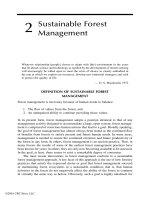International Business Management: Chapter 2 - Globalization
Bạn đang xem bản rút gọn của tài liệu. Xem và tải ngay bản đầy đủ của tài liệu tại đây (54.83 KB, 8 trang )
INTERNATIONAL BUSINESS
MANAGEMENT
Chapter 2: Globalization
1
Globalization of markets & production
• Globalisation of the market: refers the
process of the worldwide market integration
• Advantage:
– Exploitation and creation of global market
segment
– Standardization of products, packaging,
promotion
– Converging tastes and trends world wide
2
1
Globalization of markets & production
• Globalization of production: an emergence
of an integrated international production
system (IIP)
• Form of globalization of production
– Parts/components: outsourcing
– Allocated assemble: worldwide
– Sales: worldwide
3
Globalization of markets & production
• Reasons for IIP
– Assess low cost inputs
– Product differentiation
– Imitate & adapt new technology
– Assess cooperative advantage
– Breakdown of the value chain and reallocation
to the effective location
4
2
Globalization of markets & production
• How to get competition advantage: configuration versus
coordination?
• Configuration: concentrated portfolio of production site
– Technology intensity
– Access to scarce resources
– Pressure for cost reduction
• Coordination: expand the company’s subsidiaries in
various national markets
– Importance of border-crossing customer
– Presence of global competitors
– Investment is not intensity
5
Globalization of markets & production
Implication of IIP
– Economic activities formerly under national
control now under MNE control
– National economies linked through markets
(trade) and through international production
(FDI)
– Cultural convergence
6
3
Benefit & cost of Globalization
• Benefits of globalization
– Business expansion leads to economy of
scale
– Assess to resources
– Lowering price
– Economic growth
– Technology transfer
– Job creation
– And: so on…….
7
Benefit & cost of Globalization
• Cost of Globalization
–
–
–
–
–
–
–
–
Job displacement
Real wage erosion
Job insecurity
Regulation avoidance
Loss of sovereignty
Environment damage
Inequality
Global problem: financial crisis, ethic conflicts…
8
4
Limits of globalization
• Countries are different
–
–
–
–
–
–
Economic conditions
Differences in culture
Barrier to trade and investment
Political uncertainty
Corporate strategy
Difference in customer needs, behavior, government
regulation…
9
The role of MNC
• Definitions: MNC is corporation that engages in FDI and owns
or control value-adding activities in more than one country
• Characteristics of MNCs
– Carry out business activities at least 2 countries
– At least two partners which are different
nationalities
– Integrated strategy
– Integrated resources: patent, copyright, capital,
human resources,….
– Its interest is the most important thing
10
5
MNCs
• The role of MNCs: 61,000 MNCs (2003)
–
–
–
–
Employ 54 millions persons
Total sales: $19 trillions (in USD)
Outward FDI stock: $8.2 trillions
Account for 10% GDP, 1/3 world export, 2/3 world
trade at their peak
– Key sectors: electronics, electrical equipment,
automobiles, petroleum, chemicals, and
pharmaceuticals
– Some MNCs are bigger than countries: Exxon
Mobil, Siemens, Wal Mart, IBM, Toyota….
11
Are Companies bigger than Countries?
• Twenty-nine of the world’s 100 largest
economic entities are transnational
corporations (TNCs), according to a new
UNCTAD list that ranks both countries and
TNCs on the basis of value added.
• In 2002, Exxon was the biggest in terms of
value added ($63 billion). It ranks 45th on the
new list, making it comparable in economic
size to the economies of Chile or Pakistan.
Source: WIR, 2002
12
6
Are Companies bigger than Countries?
• The value-added activities of the 100 largest
TNCs have grown faster than those of
countries in recent years, accounting for 4.3%
of world GDP in 2000, compared with 3.5% in
1990.
• The world’s top 100 MNEs are based almost
exclusively in developed countries. Their
affiliates employ over 7 million people and
have foreign sales of US$3 trillion (2003).
13
Source: WIR, 2002
MNCs
• Forms of MNC’s cooperation
– Strategic alliance:
• informal agreement
• formal contract in production, R& D, and marketing
• Equity participation
– Joint-venture
– Greenfield investment
14
7
MNCs
• Entry mode to the international market
Depth of involvement in foreign market
Local production
Local assembly
Export via Subsidiary
Export via agent
License
Time
15
8









